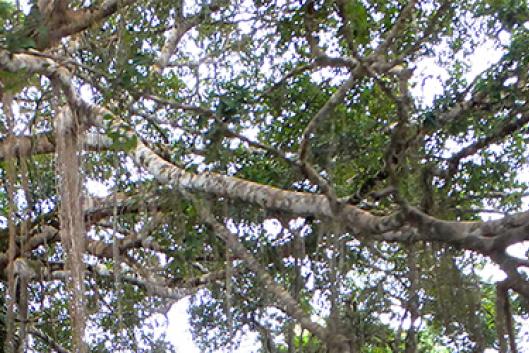In December 2015, the Paris Agreement was celebrated with great fanfare. This agreement, part of the United Nations Framework Convention on Climate Change (UNFCCC), establishes new measures to reduce Greenhouse Gas Emissions, which are responsible for global warming.
Almost a year after celebrating it, the Agreement came into force on November 4, 2016. A few days later, the 22nd UNFCC Conference of the Parties commenced in Marrakech, Morocco, supposedly to move forward with the details of implementing the Paris Agreement. (1)
After the Paris Agreement and the discussions in Marrakech, do forests and communities that depend on them have anything to celebrate? The answer is NO. Let's go step by step.
The Paris Agreement is really just another example of how corporations interested in continuing and expanding their businesses have co-opted the Climate Summit and governments' agendas, which will inevitably only exacerbate the climate crisis. An example of this is that the Paris Agreement does not mention fossil fuels, the main contributors to global warming. Furthermore, there is no mention in the Agreement of the corporations that profit from extracting and selling these fuels.
Without explaining how it will do so, the Agreement aims to "to maintain the average global temperature rise to well below 2°C above pre-industrial levels, while pursuing efforts to limit temperature increase to 1.5°C above pre-industrial levels.” (2)
In order to reach the Agreement's less ambitious goal, i.e. to limit the temperature rise to below 2°C, each country sent their National Climate Action Plans to the UNFCCC, in which they outline their contribution toward achieving that goal. However, the -voluntarily - contributions to which each country has committed, are not sufficient to reach this goal. (3) We are off to a bad start.
For the second and more ambitious goal — to limit temperature increase to 1.5°C — the Intergovernmental Panel on Climate Change's (IPCC) technical calculations linking greenhouse gas concentrations and temperature changes conclude that it is necessary to stop consuming fossil fuels by 2025-2030. They say it is also necessary to use a new technology on a massive scale to absorb carbon dioxide — increase in the concentration of this gas in the atmosphere is causing global warming — through various land sinks, such as trees and the soil. This new proposed technology is known as Negative Emissions. (4) Estimated figures say that to avoid a 1.5°C increase using Negative Emissions technology with trees, it would take 1 billion hectares of land to cover with trees, an area equal to the United States. (5)
Despite repeated warnings, the Agreement does not mention the crucial need to immediately cut emissions from burning fossil fuels down to zero (see also the article 'The Paris Agreement Undermines the Global Campaign to Leave Oil Underground' in this bulletin). It is estimated that in order to avoid a fatal outcome for many of the planet's inhabitants, 80% of known fossil fuel reserves must stay underground. (6) Yet the Paris Agreement, and thus the governments that have signed onto it, do not insist on this point. So how do they plan to make sure temperatures do not rise by more than 2°C?
One of the Agreement's central considerations — or problems — is that the focus is not on reducing emissions but "to undertake rapid greenhouse gas emissions reductions in accordance with best available science, so as to achieve a balance between anthropogenic emissions by sources and removals by sinks of greenhouse gases in the second half of this century.” (7) Solutions focus on the creation of so-called land sinks — including forests. This opens the door to carbon offset mechanisms that claim to compensate fossil carbon emissions with increased uptake and storage of carbon in these so-called sinks. Offset mechanisms allow companies or countries with a certain limit on emissions to continue polluting beyond that limit, as long as they pay someone elsewhere to reduce emissions for them. The most well-known emissions offset mechanism is the Clean Development Mechanism (CDM) of the Kyoto Protocol. (8) The message here is very misguided, and also very dangerous for the millions of people who depend on their territories for survival.
Precisely in this proposal lies the central problem of the Paris Agreement: the negation of the difference between fossil carbon and biotic carbon. However for the climate, there is a very important difference between these two kinds of carbon. On the one hand there is carbon emitted from deforestation, for example; this is part of the natural cycle of carbon emitted and absorbed by plants and oceans and which has been circulating in the atmosphere for millions of years. On the other hand, there is carbon released from extracting and burning oil, natural gas or coal. This carbon — which was stored underground for millions of years — once released, increases the total amount of carbon (dioxide) in the atmosphere. Even though plants and oceans can absorb some of this additional carbon introduced into the atmosphere, they do so temporarily. For example, when there is a fire, or when a tree dies, the CO2 is emitted again and returns to the atmosphere. (9)
Forgotten Arguments
Forests were excluded from the Kyoto Protocol's carbon offset mechanisms (mainly the CDM) for several reasons: (a) it is impossible to accurately measure how much carbon is stored in forests, and this amount changes constantly, (b) the carbon market failed to address the factors driving deforestation; carbon offset projects only push the destruction to other locations outside the project area, (c) the CDM rules would create perverse incentives, among others because the FAO definition of forests was used. This definition confuses forests with plantations and thus, the inclusion of "forests" would have created a new subsidy for the expansion of monoculture tree plantations; (d) forests only store carbon temporarily and this carbon can be released at any time due to natural or social processes. This non-permanence of carbon in trees causes many complications for the carbon market: if the carbon in trees is released, the carbon credit buyer can no longer say their fossil fuel emissions have been offset. (10)
The arguments which so far have been valid to exclude REDD projects (Reducing Emissions from Deforestation and Forest Degradation) from carbon offset mechanisms like the CDM are still valid. Nonetheless, governments seem to have forgotten them.
Despite the fact that governments excluded forests from the Kyoto Protocol's carbon trading mechanisms, those interested in doing business with REDD made sure it got on the official agenda of the UNFCCC. Because they wanted to offset their emissions or because they had REDD projects to offer, they created a voluntary market, parallel to the formal negotiations of the UNFCCC. With this voluntary market for REDD projects, governments and polluting companies, along with large conservation organizations, created pressure for REDD to be included in the "official" UN mechanisms. There is sufficient evidence that these voluntary projects and initiatives, financed by the World Bank's carbon market and by the UN itself (UN-REDD), have been a bad idea; a bad idea for the climate, since emissions continue to increase; a bad idea for forests which continue to be destroyed; and a bad idea for communities who depend on forests. The Paris Agreement eliminates the separation between voluntary markets and the carbon market created by the UNFCCC.
Ignoring all this evidence showing that including forests in carbon markets is a bad idea, REDD was recognized in the Paris Agreement, including as part of the new carbon trading mechanisms the Paris Agreement includes. The purchase and sale of carbon credits can now occur between countries in the North and the South but also between two countries in the global South. The consequences of this decision are worsened by the fact that now, under the Agreement, countries in the global South — with their large forest areas—have reduction goals to meet (voluntarily). Many have included reducing forest loss in their national plans to reduce emissions. Each country must now develop a transparent and reliable mechanism to guarantee that the reductions accounted for in the national carbon balance that all countries now have to prepare under the Paris Agreement, are not counted twice. Such double-counting could happen if provinces, municipalities or states within the country have accepted private REDD+ projects or programs that sell carbon credits on the voluntary carbon market. Counting the same reduction twice would mean the concentration of carbon dioxide in the atmosphere will be higher than the UN accounting balances suggest. In addition to the risk of counting the same reduction twice, the reality is that reductions from such carbon offset projects are always hypothetical: it is neither possible to predict what would have happened to the forest, nor is it possible to adequately calculate the amount of carbon contained in a forest. (11)
An Uncertain Future for Forests and Communities
REDD projects implemented to date have shown not only that REDD is a false solution to climate change, they have created a number of problems for local communities that have traditionally lived in forests. These problems include: lack of consultation, lack of information prior to the setting up a REDD project, and the imposition of severe restrictions on communities' use of the forest. These REDD projects also undermine communities' rights and control over their forests. This is exposed in a review of over 24 REDD activities implemented in Latin America, Asia and Africa. (12)
REDD has been unable to curb the climate crisis and the causes of deforestation. REDD has also been unable to improve the lives of forest-dependent communities. But those who signed onto the Paris Agreement remembered none of this.
(1) The UN climate talks in Marrakesh brought no significant progress in defining a road map for the implementation of the Paris Agreement. Rather, there were closed discussions on the central issues that arise from the adoption of the Agreement. Among them, the creation of a possible carbon market, the risk of double-counting of emission reductions that each country will enter into their national carbon balance sheet if these can also be sold on carbon markets and on the topic that is on the agenda each time, the financing needed for the countries in the global South and the reluctance of industrialized countries to make that financing available. See "Forest highlights from Marrakech" at http://www.fern.org/node/6209
(2) Paris Agreement http://unfccc.int/files/meetings/paris_nov_2015/application/pdf/paris_agreement_english_.pdf
(3) http://ec.europa.eu/clima/policies/international/negotiations/paris_en
(4) http://www.climatechangenews.com/2015/12/07/scientists-1-5c-warming-limit-means-fossil-fuel-phase-out-by-2030/
(5) Going Negative, How carbon sinks could cost the Earth. FERN. http://www.fern.org/sites/fern.org/files/Going%20negative%20version%202.pdf
(6) https://www.theguardian.com/environment/2015/jan/07/much-worlds-fossil-fuel-reserve-must-stay-buried-prevent-climate-change-study-says
(7) See article 4 of the Paris Agreement at: http://unfccc.int/files/essential_background/convention/application/pdf/english_paris_agreement.pdf
(8) More information at Carbon Trade Watch: Carbon Trading – How it works and why it fails. http://www.carbontradewatch.org/publications/carbon-trading-how-it-works-and-why-it-fails.html and in the Friends of the Earth International brochure: Financialization of Nature: Creating a new definition of nature. http://www.foei.org/resources/publications/publications-by-subject/forests-and-biodiversity-publications/financialization-of-nature
(9) (10) To read more: 10 Things Communities Should Know About REDD. http://wrm.org.uy/books-and-briefings/10-things-communities-should-know-about-redd/
(11) The introduction to the publication '10 Things Communities Should Know About REDD' explains why we must talk about hypothetical emissions reductions in the case of carbon calculations in forests, rather than real and verifiable reductions.
(12) REDD: A Collection of Conflicts, Contradictions and Lies. http://wrm.org.uy/wp-content/uploads/2014/12/REDD-A-Collection-of-Conflict_Contradictions_Lies_expanded.pdf

